-
Posts
5,779 -
Joined
-
Last visited
Content Type
Profiles
Forums
Articles
Gallery
Downloads
Events
Posts posted by jlpservicesinc
-
-
NICE.. That will make a great anvil like object.. Looking forwards to seeing it mounted.. The composite wood bases would work perfectly..
-
SQ tube also depends on wall thickness.. Different wall thicknesses offer different side profiles.. Steel shot inside the tube is much cleaner Vs sand but not as cheap..
if you use anything loose like sand or shot you have to cap the ends after filling and compacting to get the best side wall support.
-
40 minutes ago, Frosty said:
Yeah, we're all a little crazy or we'd play at easier hobbies it's just some of us do prettier crazy.
Frosty The Lucky.
I'm with ya.. Funny thing is with being a farrier the blacksmithing is a much easier gig.. If someone wants real crazy try being a farrier..

-
11 hours ago, Anachronist58 said:
Your work made my heart skip a beat...... Delightful.
Robert Taylor
Thanks Robert...
8 hours ago, Frosty said:#4 is delightfully over the top for a forge tool, I like it. They're all nice tools but if you let them vote I'm betting on NEB electing #4 handles. I would
Frosty The Lucky.
I got a little crazy.. Thanks Kindly..
8 hours ago, Daswulf said:They are all good but that heart one Is really nice. I have to ask did you make a heart shaped punch? Glad your getting back into the swing of things.

Heart punch and heart drift.. clean up with rat tail file..
Thanks,, Me too.. Be nice once I can get the brain to get back into focus (it wants more options when only one is correct).. The arms are working well (muscle memory).. but the thought process is still a little slow.. Of course I'm 10 years older so maybe that plays in..
-
Well after this past week today was a great day to get out in the shop and do some making..
Since I offered to make the forge tools for the NEB group it was a good day to get started..
I made 4 handles all of a different design though 2 share the same concept.. Well maybe 3 if you consider a twist a concept.. The 4th tool was just to have at it and push the boundaries..
Feels good getting the cob webs off the old brain and things are starting to make more sense again.. Lot less hits on the anvil to maintain cadence and lot more work being done at each heat..
Anyhow, I made the 3 rakes today and 4 straight pokers.. The rakes were a lot of fun to make and the last one was especially fun.. a few more forging days and I should be back in pretty good shape..
I'll add the shovels to this thread at another time since I still need to make them.. still not sure on handles.. Shovels can take a little longer to make since I have to make all the parts.. Ah..
-
On 10/4/2016 at 11:13 AM, aessinus said:9 hours ago, Daswulf said:
JLP, physics of certain things for me barely sink in. Other things make perfect sense to me. So, sometimes I just have to see for myself. Tho I wasn't arguing.
So after using these two other pokers ( since they were there and premade), I decided to give that design a shot.
The wooden one was light and I liked it but some joint in the handle delaminated and I had this other poker looking thing which is heavy and a bit awkward. So after giving the style you show a try, I love it atleast after one night so far. Good control and balanced. Thumbs up. I didn't forge weld the handle since I'm not good at that yet and even had a nicer scroll on it before messing that up but what the hay. It's comfortable in the hand and works great.
Nice job on the rake.. Like the handle and twist design, you spent some time on it cutting in the line in the handle and such.. I find it is less tiring in use with the offset hook maybe you will find the same thing..
In overall reality the handle design (comfortable, plenty of leverage) can play a more important role (straight vs looped) but the tool as a whole makes or breaks the design.. Nice execution.. Thanks so much for sharing..
-
Excellent work.. Love seeing artistry..
-
11 hours ago, Daswulf said:
Excellent JLP. if you find it please post it. lessons are best. it's been tough trying to get out to any groups for me lately. I look forward to when I can.
the video is crappily done.. I did it a few years ago to show an online group how to make chain.. Really the best part is the very beginning and the very end where I test the chain I just made..
There is/was actually 2 videos the 2nd one was better.. I actually took off over 10 years from the blacksmithing.. Didn't touch a hammer or anything so the skill set is only now starting to come back.. At this point I have forgotten more than I know. Getting the new trailer up and running will allow for me to have somewhere to work till the shop is up..
anyhow, i"ll make a new video and post it. We'll get you something else to watch..

-
41 minutes ago, Daswulf said:
Yeah I'll keep trying here and there when I can. lessons sound like the ticket. I know it's not my forge because a friend forge welded in it when her was here. I've read on it I just dont practice enough.
I posted a video on chain making somewhere.. You tube or else where a few years ago.. Also one on tong making.. Really a lesson is best. I gave a lesson to a guy at the last NEB meet and he got his first forge weld under his belt..
-
16 minutes ago, Frosty said:
Test looks successful to me. Nice wall hook. Does it hang straight on the single screw with say one heavy coat on one side? I like the looks of a single screw but they tend to go a little shifty on me.
Frosty The Lucky.
to correct this it just get another nail in the crotch at the split.. there is another nail under the group of S hooks..
Yes it was successful.. Thank..
8 minutes ago, Daswulf said:If you didnt say it was forge welded I wouldnt know. Nice work. hope I can forge weld as well one day.
Thanks.. You'll get there.. keep practicing and a lesson or 2 and you'd have it solid..

-
-
2 hours ago, rockstar.esq said:
jlp, I think I see where the fundamental misunderstanding lies. I thought you were saying the crooked rake had a shorter length handle to match the non-crooked rake. I think I just assumed that the stock to make the handle was drawn out to make the crooked version. Sorry, I added that confusion.
Thank you for your patience with me. I've sincerely wondered why people made their forge rakes that way for years. I've found time and again that old blacksmith designs have a lot of subtle wisdom in them.
Sorry if I sound grumpy.. OK.. I'll try this one more time..
Torque is the amount of twisting force as measured in ft lbs, inch pounds, Newton meters so on, and so on..
A lever with a fulcrum.. IE : Balance beam.... 100 lbs at each end with a pivot or fulcrum in the middle with this beam exactly in the middle should be even both sides..
If you don't change where the fulcrum is on the board supporting the 100lbs on each end. But make one side of the board longer.. Now because one side is longer that 100lbs has a greater weight advantage.. This mechanically adds more torque to the area in contact with the pivot and as the stiction is overcome the longer end will start to move towards the ground..
The same is true if we keep the board centered and instead of having 100lbs at each end of the board we have 100lbs at one end, and we put 200lbs at the other end.. Now if the board is 20ft long and we move it from the middle and we move it 10ft towards the 200lbs side the beam with the weight will now be balanced.. but one side will be longer than the other but still in balance..
So, by offsetting the hook to the back side of the shaft.. You are actually moving the pivot point.. While not that far it does add up..
So, again.. it doesn't matter whether the hook is offset or not in use..
But, you can add more torque to the shaft and since the pivot is not moved further along the lever you can put in more less perceived torque when you turn the shaft and get more power at the end.. Vs at a 90D to the shaft..
But, since it's the handle you are holding that can feel good in the hand the hook end plays very little into how your hand feels on the handle and perceived power being put into the handle to turn the rake..
I don't use a rake as my only forge tool.. I use it to shuffle around coke and coal but usually just to pull clinker out, break up large coke lumps but that's about it. Oh and poke holes in the top of the fire..
My recommendations are to make a handle that is comfortable that you can apply ample power (CONTROL) to and it doesn't make your hand tired.. Remember when you work, each items you have to use should enhance the job at hand and not tire you out any more than needed..
-
2 hours ago, rockstar.esq said:
JLP Thanks for the replies, I think I understand where you're coming from, however I don't think things add up. If you were point down, pulling up on the poker, the fulcrum would be wherever the axis of the handle meets the axis of the blade. It doesn't matter if the poker is L shaped or crook shaped. The extra bit above the axis is irrelevant to the leverage because the forces are calculated in straight lines off the fulcrum.
The distance from the fulcrum to the point of force defines the leverage. It doesn't matter how curvy the lever is, only the distance between the fulcrum and the point where force is applied. That's why we use longer levers, rather than curvy levers.
It's my understanding that the swept spokes in pulleys was to aid in casting. It stands to reason that curvy cranks were cast that way for the same reason. I have very little first-hand knowledge of casting so I'm merely repeating what I've heard.
Boy, what is a girl to do..
Please go back to the drawings.. The distance from the fulcrum to the point is the difference.. if the handle is in the center.. Or the pivot. then in theory you would gain a small advantage vs a bent 90d straight off the shaft.. Since the fulcrum/pivot point are the same as the center of the shaft.. A bent back and hooked rake has the leverage point behind the pivot instead of in front of it like a 90D poker.. So in theory you have moved the fulcrum more towards the center of the hooked piece vs to one side of the shaft.
Okay.. I can see you guys simply don't get it..
While yes, one could say a swept cast iron spoke was done that way to offset some of the forces of the casting cooling.. it's not only castings that were done that way. and it goes way beyond why cast iron has swept spokes.. It also has to do with torque transmission, etc, etc.. . It has to do with how a swept spoke will lead a socket/shaft around vs a straight spoke.. A swept shaft on a handle will pull or push in a straighter action than a straight shaft which will create more of a side load as the shaft center pivot since the handle is mounted to the opposite side..
Really the whole thing is irrelevant.. Just sharing the knowledge but you guys have to be willing to do some homework on your own..
The tire thing works on the same principle.. Anytime you move a pivot onto the other side of a pivot,fulcrum, etc etc.. the force becomes less on the other side.. It will ease the work at hand..
I don't know how to explain it any simpler than I all ready have..
Don't believe me make 2 poker's exactly the same except put the hook on and learn for yourself..
Sorry but really I've had enough of the whole thing.. Make pokers how ever you would like. It's all good..
Sorry, and not to be rude, but this isn't something I find important enough to spend any more time on.. Thanks for all the replies..
-
Buzzkill, Any luck?
I"ve watched old video footage of many a forge being oil fired even back into the 1920's The most recent was of an axe company in Maine that ran into the 60's.. They used oil fired forges..
There has been more technology that has gone to the way side as modern innovation has taken hold.. Funny we still use coal forges, wood forges, gas forges right..
When will a solar forge be developed???
Anyhow, I'd love to see how they used to do it.. I still have a gasoline blow torch which I used to use all the time.. It's only since i moved into the new house that I stopped using it simply because the leather finally wore out on the pump..
I think anything can be safe (lots of things were used for 100years safely) as long as you understand the procedures and/or the assumption of risk is taken into account..
From what I understand, the oil can be be fed via gravity though it is ran through a heat exchanger of sorts before it reaches the fire.. But again I lack 98% of the information to be helpful..
-
Like Frosty said.. Looks good.. As for the welding heat thing.. You can also use a long straight poker with a flattened end with a little flux on it and as the metals come up to tempurature you can use the straight poker to see where it sticks.. When you get ot the right temp the poker will stick and you will have to twist it off..
Sure sign you are there..
-
2 hours ago, Remorhaz said:
Hi all,
First time poster. My son and I are just getting into blacksmithing. This is our first anvil, we picked it up at an antique shop in N. Ga. It's pretty worn, the edges are rough and it has a dip in the middle, but it still rings like a bell and moves metal really well. Markings say 106 lbs, weighs in at 104 on my home scale. From what I found on the 'net this appears to be a Peter Wright imported by Boker for Trenton. If anyone can confirm or deny it would be appreciated.
Remo
German made Trenton.. I have one in 155lbs... They are a nice anvil.. Enjoy.. Welcome to the group..

-
nice work.. Love to see a different take on things.. Love the colors.
-
5 hours ago, ggraham said:
From a 3/4 inch anchor bolt about 18 inches long. One of my first attempts at long twists. Also an early exercise in drawing out.
I originally had just a 90* on the rake end but changed that about two years ago, when I added the curved portion and the offset taper.
then rake was too long to hand from forge table without dragging,
I then changed the "eye" end to a "hook" end, it's current status until the next 'better idea'.
this is a good thing, you can modify your stuff when the need arises, especially tongs.
George
George, Nice rake.. I find I like my rakes to about long enough to go from the far side of the firepot to the forge on my side.. This seems to be the theme I follow.. average length seems to be about 26".. I have 4 of them and 4 straight pokers on the forge.. I know I have 1 of each from the shop, but don't remember when or why I made the other ones..
You did a great job on twisting it up.. Cold or Hot? The loop handle like that will give pretty good control.. I usually turn the work end 90d to the handle this way the handle lays flat in my hand..
The forge setup looks nice.. Hows about a few of that as well..

-
From Wikipedia
law of the leverEdit
The lever is a movable bar that pivots on a fulcrum attached to or positioned on or across a fixed point. The lever operates by applying forces at different distances from the fulcrum, or pivot.
As the lever pivots on the fulcrum, points farther from this pivot move faster than points closer to the pivot. The power into and out of the lever must be the same. Power is the product of force and velocity, so forces applied to points farther from the pivot must be less than when applied to points closer in.[1]
If a and b are distances from the fulcrum to points A and B and if force FA applied to A is the input force and FB exerted at B is the output, the ratio of the velocities of points Aand B is given by a/b, so the ratio of the output force to the input force, or mechanical advantage, is given by
-
{\displaystyle MA={\frac {F_{B}}{F_{A}}}={\frac {a}{b}}.}
This is the law of the lever, which was proven by Archimedes using geometric reasoning.[2]It shows that if the distance a from the fulcrum to where the input force is applied (point A) is greater than the distance b from fulcrum to where the output force is applied (point B), then the lever amplifies the input force. If the distance from the fulcrum to the input force is less than from the fulcrum to the output force, then the lever reduces the input force. Recognizing the profound implications and practicalities of the law of the lever, Archimedes has been famously attributed with the quotation "Give me a place to stand and with a lever I will move the whole world."[3]
The use of velocity in the static analysis of a lever is an application of the principle of
-
{\displaystyle MA={\frac {F_{B}}{F_{A}}}={\frac {a}{b}}.}
-
5 hours ago, Frosty said:
You didn't break many lug nuts on the hoist did you? When the tires are off the ground inertia certainly is a factor, trying to hold the tire with one hand is doing it the HARD way. You apply pressure to the wrench in a quick snap pitting your muscle and the momentum of your mass against the inertia of the wheel to break the nut. We positioned the wrench as directly across the center of the wheel as possible to take as much advantage as possible. Did it professionally for a few years, seasonal tire change-over rush was a heck of a busy time for breaking lug nuts. Dodge lug nuts are left hand thread on the left side you know.
No we used impact wrenches most of the time but there were nuts on too tight for the wrench to break and if you tried you'd snap the lug off before the nut broke. Of course the car was always on the lift with a couple tires off so you couldn't set it back on the ground so we had to do it the hard way.
It's the same principle at work in your pokers you've reduced the leverage advantage against the handle for the same length rake. Elegantly effective and attractive fire tools. I like them a lot.
Frosty The Lucky.
We digressed.. Please don't make assumptions on ability or knowledge.. The idea wasn't on how to change a tire or the right way to do it nor the way an air impact wrench works.. The lift or hoist as you called it irrelevant to the diagram I posted..
It was a way to suggest how in a simple way to see the advantage of moving the leverage point behind the handle with an offset.. I explained the operation in full detail in the post..
All I suggested is": If you want to try it.,. If you don't see the advantage.. Try it on a tire with the wrench or torque wrench on both sides.. as in the diagram.. I never mentioned on tight lug nuts or lug bolts.. Please forget about loosening them.. In the example the tire is getting put back on or the lugs are all ready loose.. LOL>.
 or
or
If you can figure out a simpler way to explain it be my guest..
Glad you like it.. Thanks
-
Just now, Frosty said:
It's easier to break the lug nut in fig 2 because the moment of leverage against turning the tire is less while the moment of leverage against the nut remains the same. The inertia of the wheel is unchanged so the effect is multiplicative(?) rather than additive.
Measure how far the handle is from the center of the tire rim as opposed to the center of the lug nut.
Close?

Frosty The Lucky.
Yes and no since you aren't using mass to move it. if the tire was in motion then what you wrote would apply as you stated inertia.. As then youd being using the mass of the rotating tire to break the lug nut free.. If you substitute torque for inertia then the answer would simply be "Yes"..
In my example the tire is stationary and you are holding the tire with one hand while torquing the lug nut after putting the rim back on the car..
Same applies when loosening the lug nut but you would never be able to hold the tire and break the stiction of the nut and rim.. It's why I used the tire all ready off and putting it on and torquing to value..
there is also a leverage ratio which gets applied as the lever moves by the rotational center of the mass since it's actually a dual orbit affair.. (around the center mass, and off center of the rear of the shaft.. This creates a convergence point if both bodies were rotating or there was the ability to clock the pivot points as in the picture..
center orbit of the whole tire turning. (same as twisting the poker at the center shaft) offset center of the back of the shaft (lug nut/bolt location), and then simply rotating the second point (work end of poker long side) .
If you were to look at the end of the poker it would align with the figure 2 vs figure 1.. and figure 1 would align with the blade only coming off one side..
Anyhow, I've had enough.. My brain hurts.. It just works..

-
1 hour ago, rockstar.esq said:
JLP, I'm confused. It sounds like you're saying the crook design reduces the torque at the handle end. I'm imagining the tip pointing straight down in coal, and the user rotating the handle to move the tip left or right in the coal. I would expect that the torque would be a function of the radius from the center of the axis to the tip of the moment arm. Since both examples you gave have the same dimension (1.25") I don't see how they could have any difference in leverage.
It seems like the additional weight of the doubled over crook portion would act as a counter weight that would create torque in the opposite direction of the users rotation. I could definitely see that feeling easier to the user.
Frosty's point is a particularly good observation that makes a lot of sense to me. That lead me to notice that the crooked tool pulls less material than it pushes as a rake. That makes it possible to quickly push coked material towards the center of the fire, while still being able to deftly move material around the stock.
It does make it easier.. Look back at the drawing and while it looks deceptive it actually does work.. the weight has nothing to add as far as a turning tool.. In smacking coal it does..
If you look at how old hand driven items and how there handles were swept away or towards the direction of travel (away was the preference) vs just a straight handle.. There is actually a science behind it and wasn't done simply as a decoration..
Your going to make me break out the geometric function of levers and pivots aren't you.. ??????????
The easiest way to explain it is: If you have a car tire up in the air with no brakes on and you are tightening the lugs after you have taken the old wheel/rim off..
If you put the lug wrench on the off center side (fig 2) You can hold the tire more easily than if you had it as in figure 1..
The tire example is a great one.. If at some point you still don't believe.. Give it a try see which is easier to hold.. You will find that Fig 2 is the easiest almost exactly at the center line of where the lug nut/lug bolt and the center of the axle are in alignment. about 40 degrees of arc swing through this center will offer the proof.. Near perfectly centered is where you will be able to put maximum torque on the wrench while still holding the tire fairly easily even if torqued to 80-90ftlbs as recommended by most auto MFGs..
Forget about holding tire in figure 1 at those torque values unless you are a hulk..
-
1 hour ago, Frosty said:
Goodness JP you have a way of starting good discussions don't you? Off setting the rake bend like that does indeed improve the user's leverage but is a real improvement I haven't seen mentioned yet. The back bend makes a nearly perfect coal hammer for breaking up coal to your preferred size.
I like it all round it's made to work well, it looks good and you made it yourself, what could be better? Darned if I hadn't looked at the pics of the loop 2-3 times before my curiosity led me to look close enough to realize that wasn't some mysterious feature of the joint but your trademark. I may be slow sometimes but I get there eventually.

Frosty The Lucky.
Frosty, I'm just getting ramped up.. I've been sleeping for 10 years so the skill set if rusty.. LOL no pun intended.. Ok.. maybe a little bit..
Thank you.. I actually have 3 touch marks small anvil, large anvil and 2/2 or 2 dots over 2 dots as a representation of zero.. In the olden days it was considered a travesty to make a beautiful peice than deface with a makers mark.. So the 2/2 can be seen as a decoration of sorts, yet is my mark just the same..
You can see it clearly here on the spring lock..
1 hour ago, Smoggy said:Thanks for the reply jlp. makes perfect sense once pointed out, and for your input too Frosty, that would have probably been obvious to me had I ever seen this type being used. And now armed with that information I'll likely look to apply the same principles elsewhere. Cheers again guys.
My pleasure.. Love to see your item when/ if you make a new one.
I will be making a few more as I believe I will be making some more as well as shovels to donate to the NEB for the new forge setups they have if they approve my offer.
-
5 hours ago, ggraham said:
I have tried both, now I know why I like the offset better besides being able to move more material and get into corners better with the forged point on the end, point is a single sided taper.
Sorry, no pictures handy.
George
Post one up when you have a chance.. Love to see it..
I leave a rounded end on the work side.. I used to do an offset bevel, but found I didn't use it enough to have it.. I use a shovel, rake and straight poker/welding feeler as my forge tools..

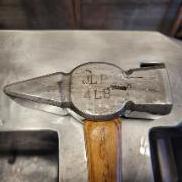
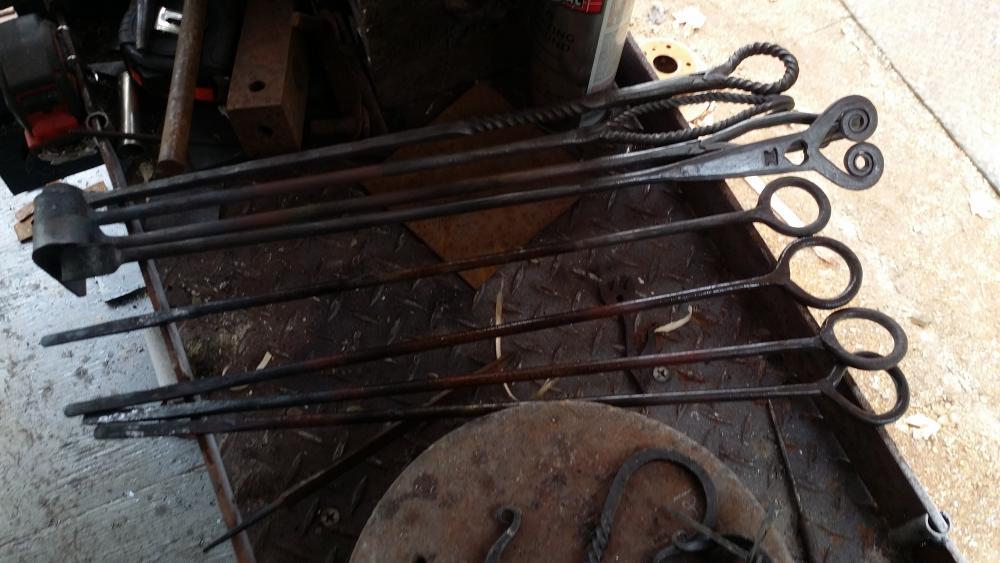
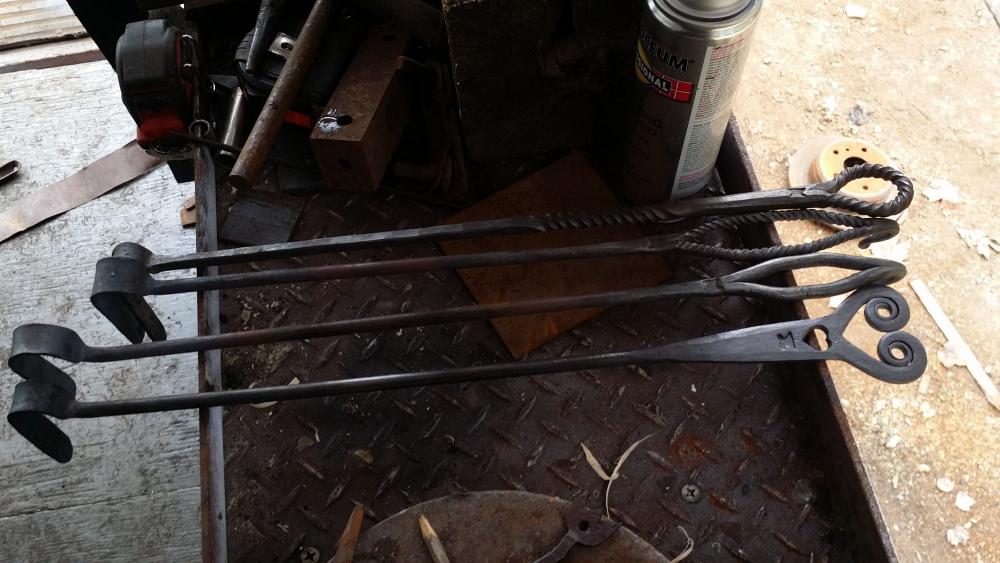
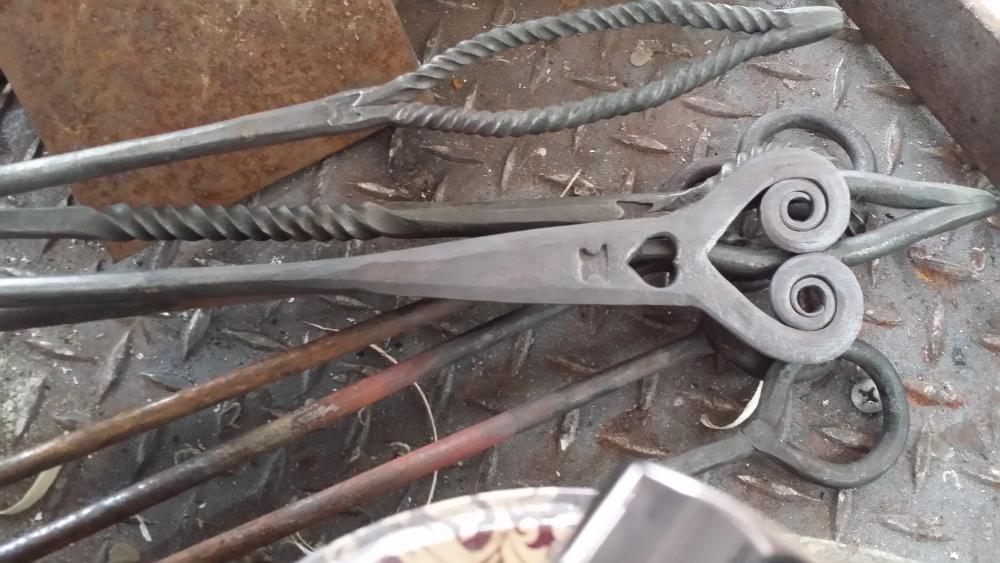
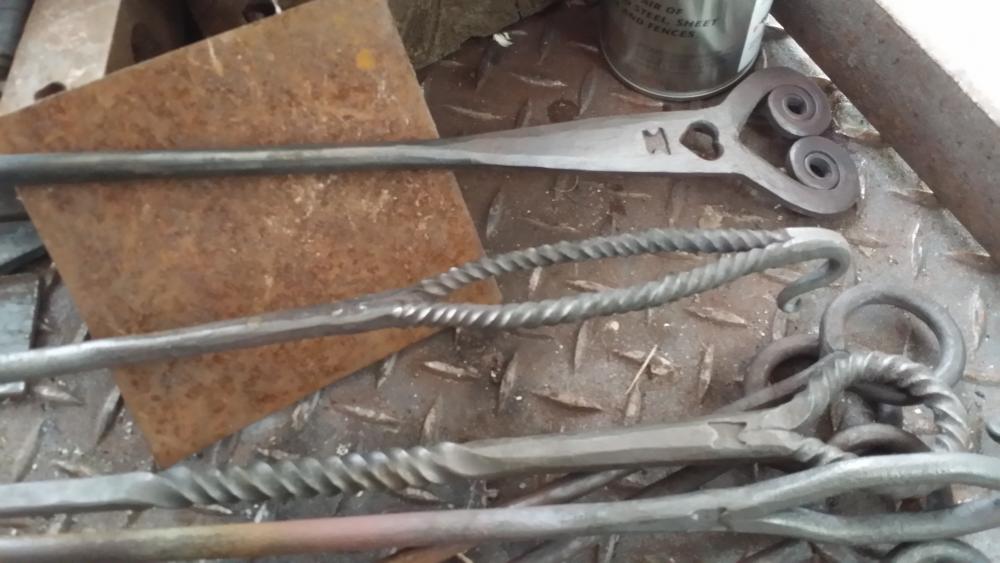
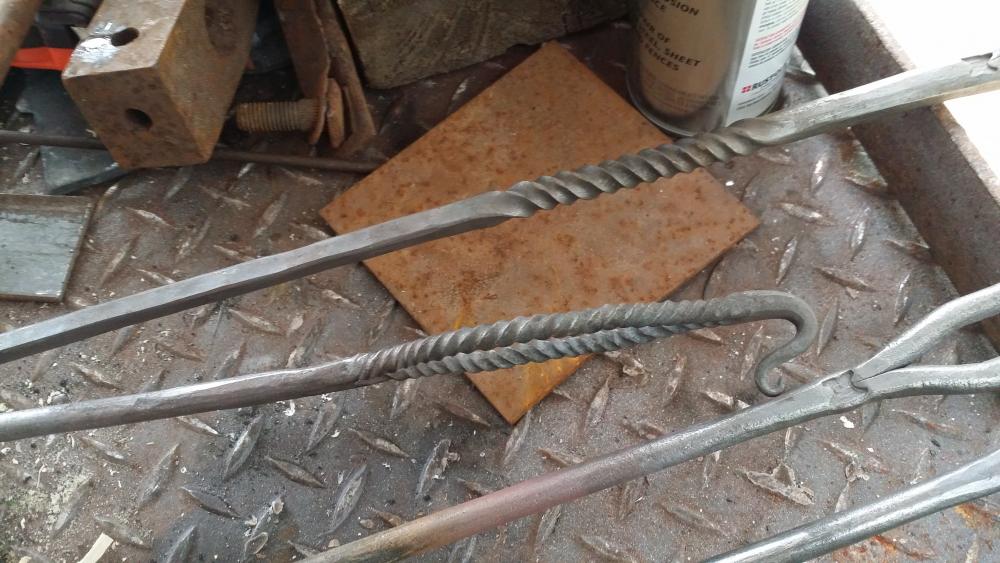
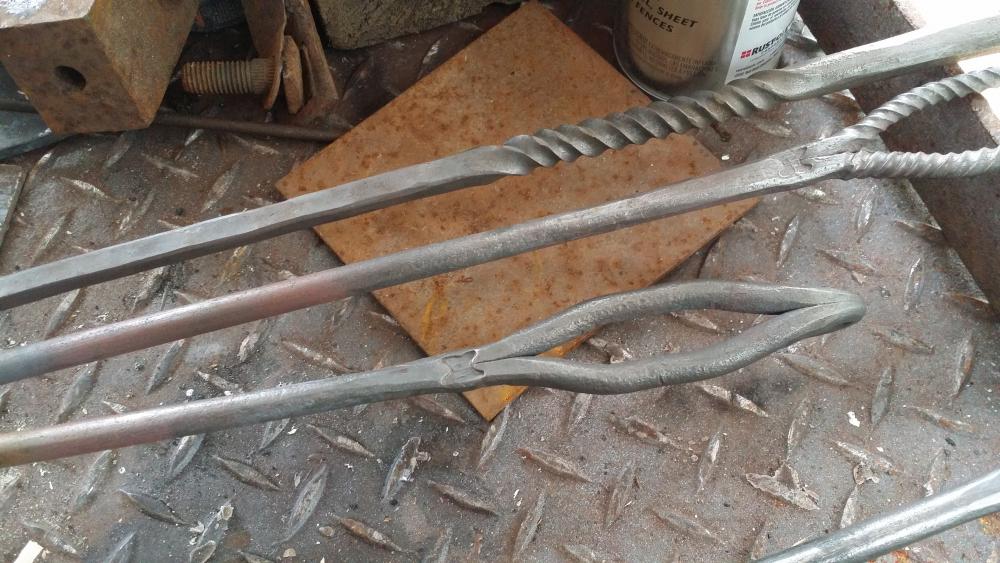
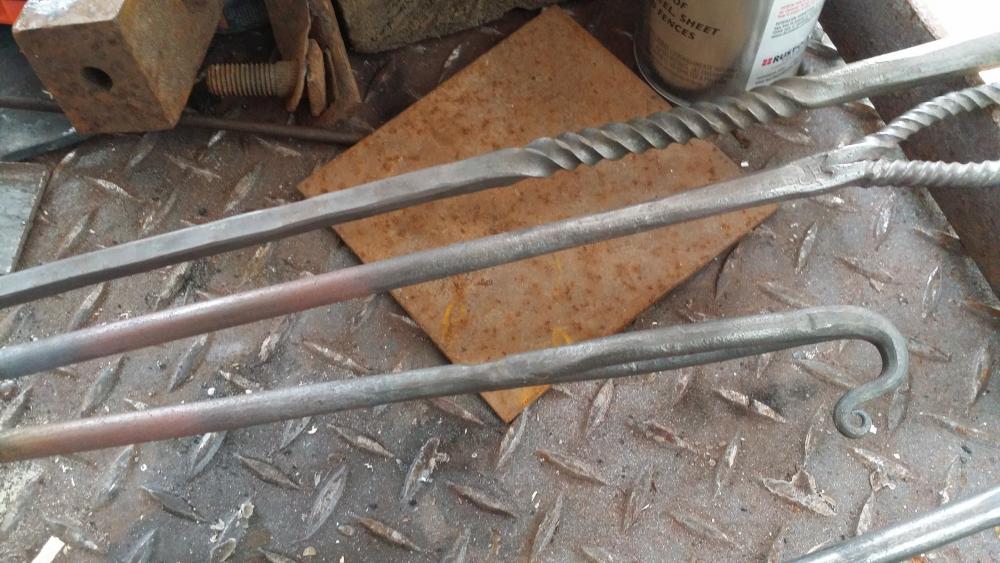
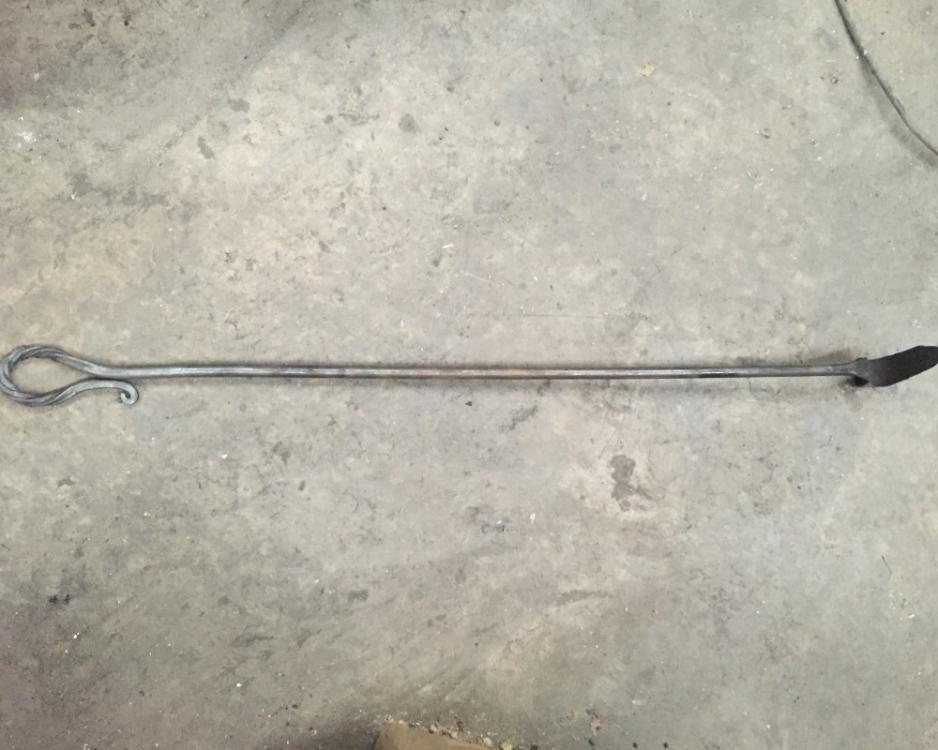
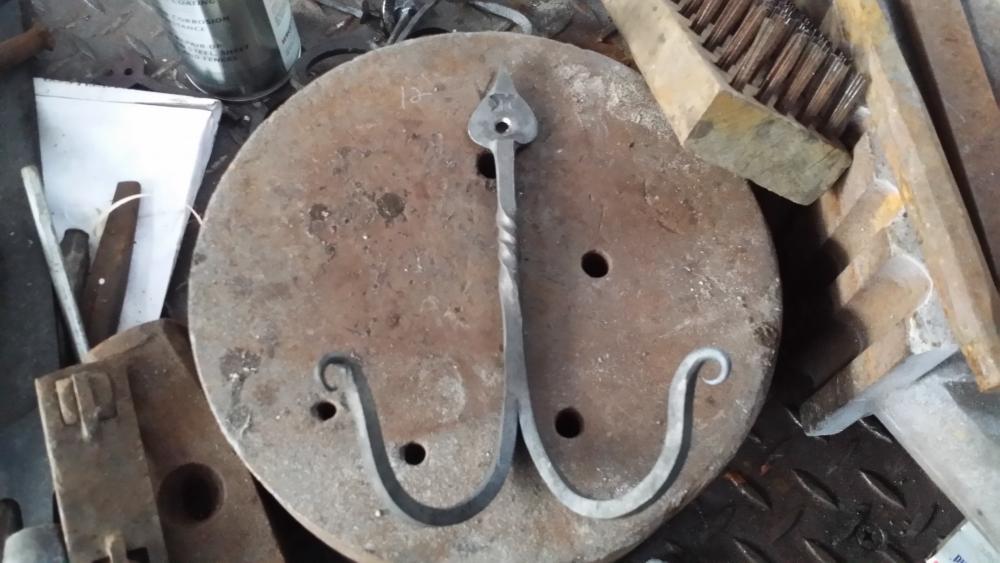
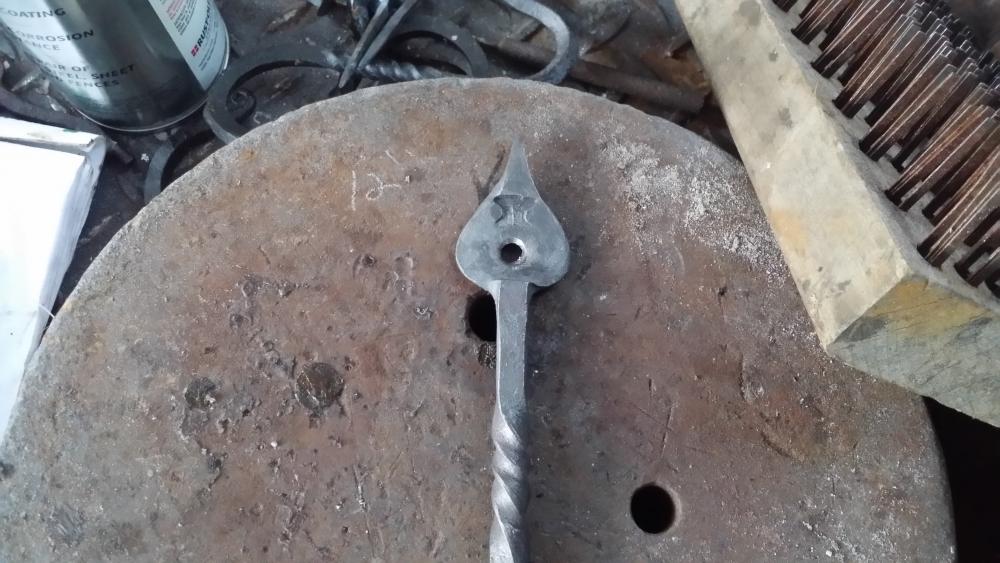
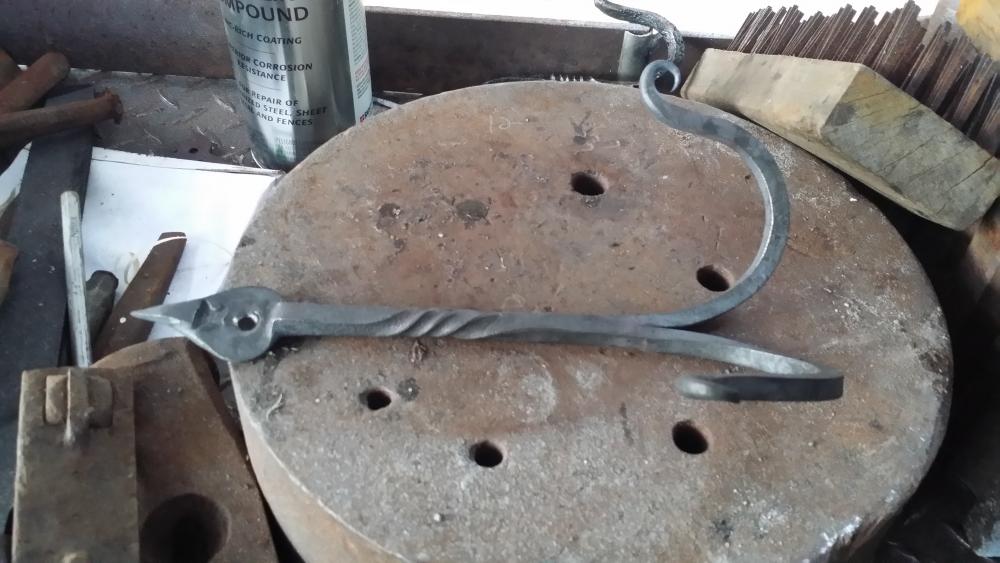
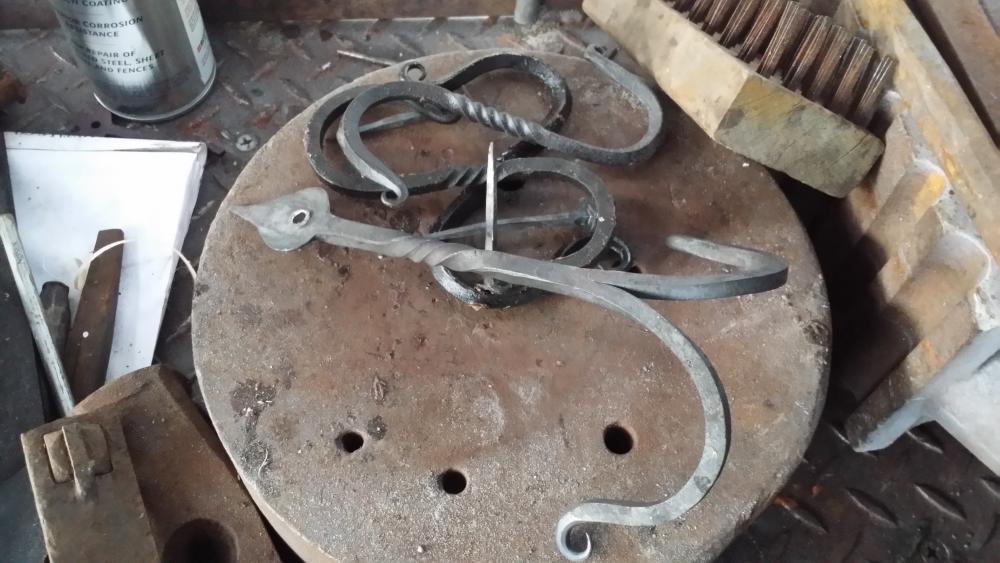
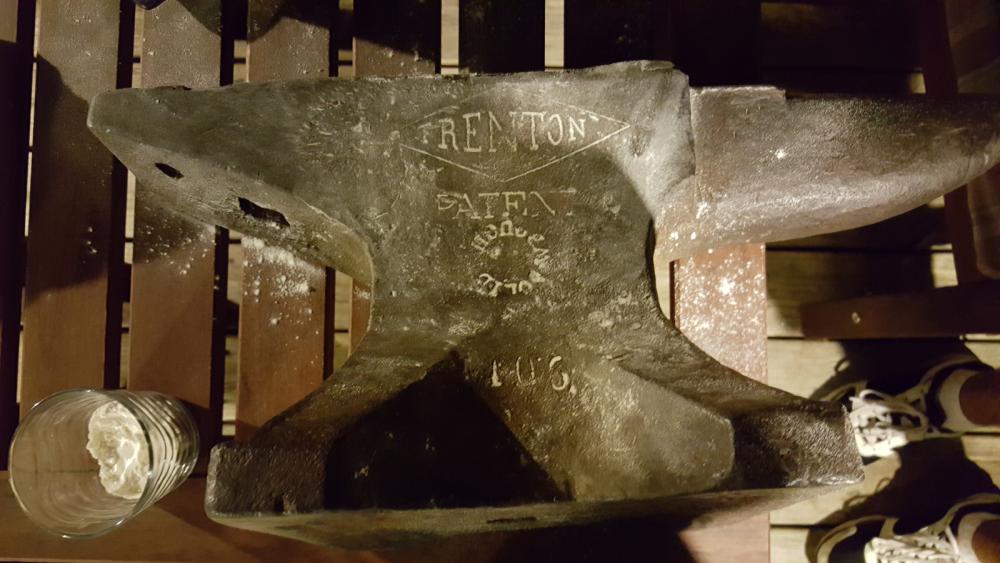
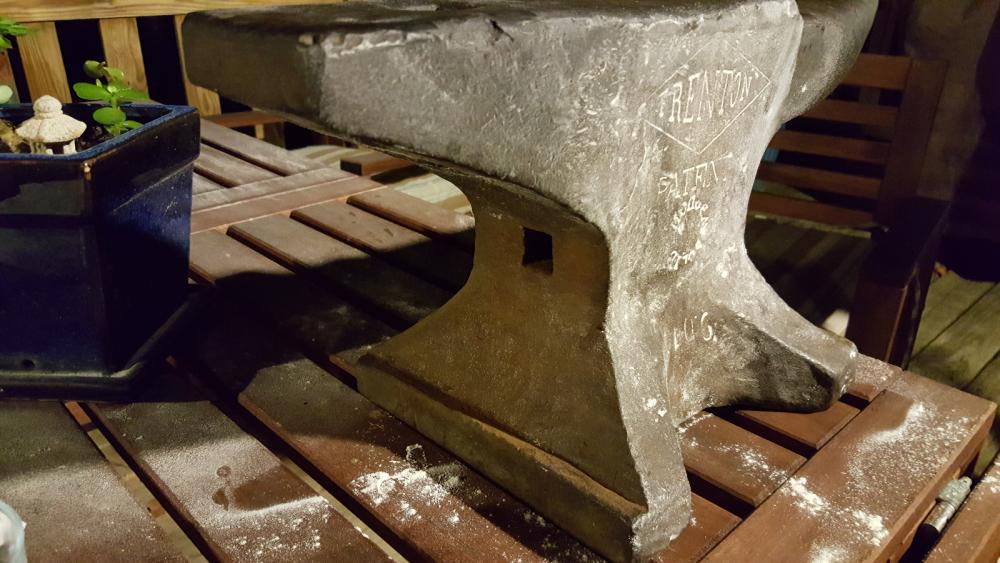
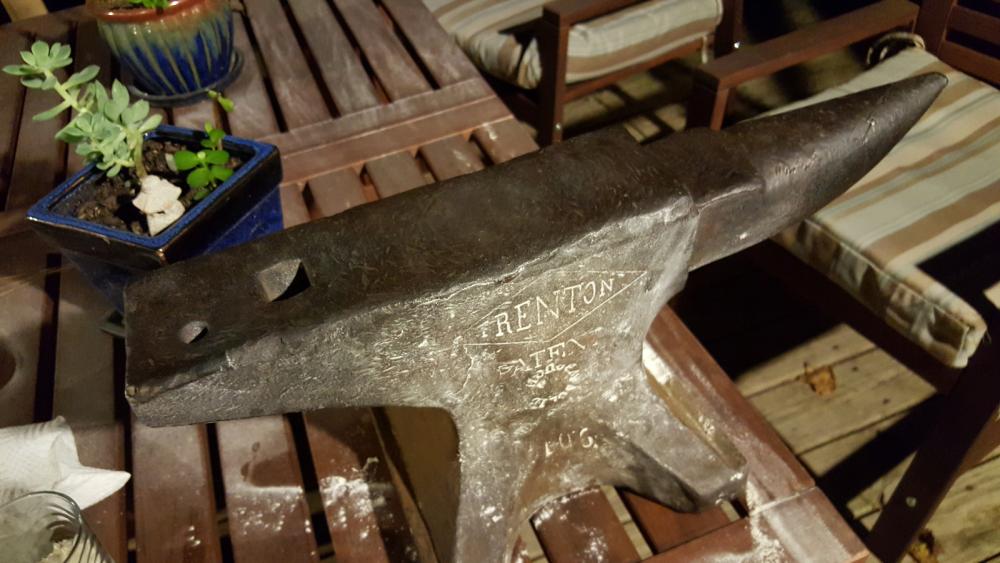


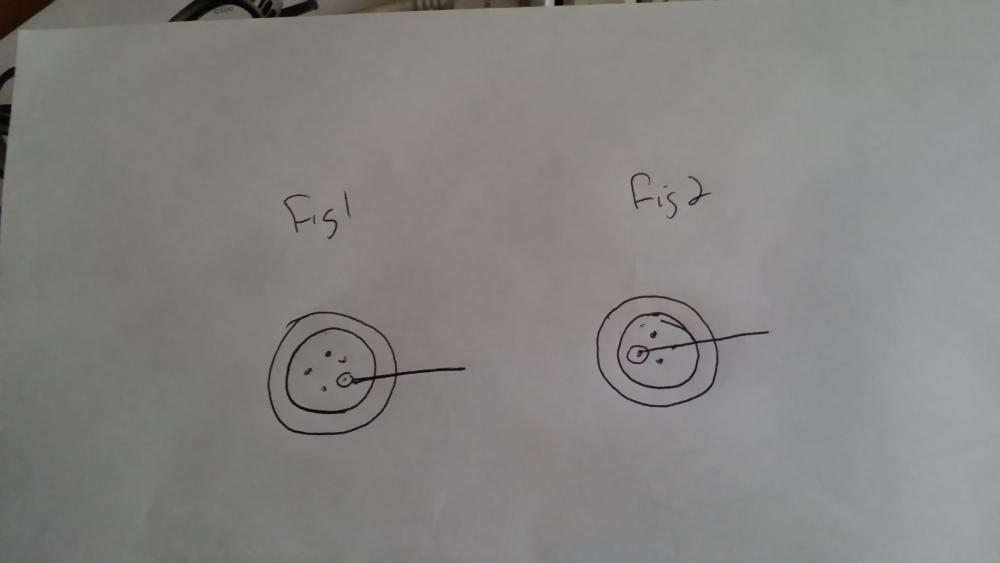
.png.c95654babe8bffd229c4d0c3e739f85a.png)
Anvil height, how can you tell if it is the right height
in Stands for Anvils, Swage Blocks, etc
Posted
its like anything the human body is only designed for so many cycles.. Each person has their own limits..
I started smithing at age 10.. by age 16 I dropped out of school because I didn't fit in. wasn't challenged enough. etc, etc.. Anyhow, by the age of 17 I had started forging a lot.. I was in search of knowledge and worked constantly to get better at forging.. Real forging not just mushing iron.. 10+ hours a day as long as I had coal..
I did professional smithing for 8 years.. (professional = making a living full time) i used to spend 10-14hrs a day standing at the anvil forging steel into anything and everything.. Anyhow, I got burnt out.. People Lost vision.
Lost vision.
I took off 10 years of forging iron. My shoulders and elbows hurt about 2 years after closing up shop though I was still hammering/shaping horse shoes..
The only time my shoulders, elbows and wrists feel any good is after a few days of smithing.. Real forging.. then I can actually raise my arms above my head with full joint rotation..
So, as to anvil height.. It's what works for that person but most people simply get locked into what the anvil is resting on and then it stays that way for 20 years..
Back before I got lazy (when I was smithing full time in my 20's.) I was far from lazy and kept adjusting the anvil height (and leave it that way for months) till I found worked best overall and put that into my main anvil.. The sledging anvil was about 3" shorter in height..
Now with how the anvil and stand are mounted in the trailer I can adjust height both with floor height and I have extra guides on the stand so I can loosen the bolts, slip wood boards underneath and change the height up to 3".. I get 6" usable adjustment but changing floor height so this is 9" of total adjustment.. Perfect for a new student who is looking for the right height.. Which again changes depending on type, and size of materials..
Because of the amount of time I have forging and working moving metal I can tell almost instantly if I like the anvil height or not.. But this also applies to forge, blower and vise height.. Which are just as important. Also power hammer height which most we designed around people born in the 1800's and were much shorter than people today for the most part..